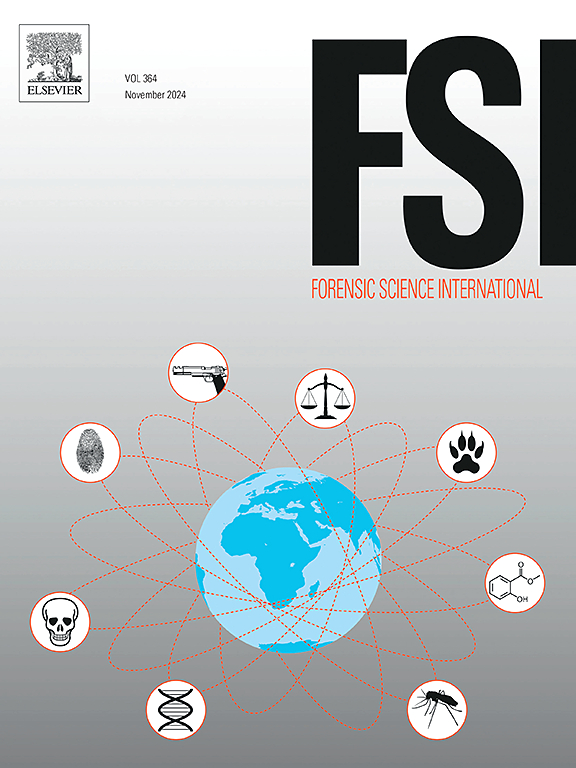The assessment of Solstice® PF as a carrier solvent for amino acid sensitive fingermark development techniques
IF 2.5
3区 医学
Q1 MEDICINE, LEGAL
引用次数: 0
Abstract
Amino acid sensitive fingermark detection techniques like 1,8-diazafluoren-9-one (DFO), 1,2-indanedione/zinc chloride (IND-Zn), and ninhydrin (NIN) commonly contain 1-methoxynonafluorobutane (HFE7100) as a carrier solvent for the visualization of latent fingermarks. As a result of the cessation of manufacturing by the end of 2025, and potential environmental regulations, an alternative carrier solvent must be validated to replace HFE7100. In this study, the relative performance of Solstice® Performance Fluid (PF) (trans-1-chloro-3,3,3-trifluoropropene) was compared to that of HFE7100 using 6000 natural fingermarks, aged for either one week or eight weeks, from five donors on five substrates (white copy paper, brown kraft paper, bubble envelope, lined notebook, magazine). Split fingermarks were treated with DFO or IND-Zn followed by NIN (DFO/NIN and IND-Zn/NIN, respectively) or NIN alone. All fingermarks were evaluated using a modified University of Canberra comparative scale by three assessors and, for differences in identification rates, by a former forensic identification practitioner. Results from this study showed comparable fingermark enhancement between the two carrier solvents after each treatment within the three technique sequences. There are some limitations with Solstice® PF, notably, an increase in ink diffusion and the need to store working solutions in a refrigerator or freezer.
Solstice®PF作为氨基酸敏感手印显影技术载体溶剂的评价
氨基酸敏感手印检测技术如1,8-二氮芴-9-酮(DFO)、1,2-茚二酮/氯化锌(IND-Zn)和茚三酮(NIN)等,通常含有1-甲氧基非氟丁烷(HFE7100)作为显示潜在手印的载体溶剂。由于2025年底停止生产,以及潜在的环境法规,必须验证替代载体溶剂以取代HFE7100。在本研究中,使用来自5个供体的6000个天然手印,在5种基材(白色复印纸、棕色牛皮纸、气泡信封、内衬笔记本、杂志)上放置1周或8周,比较Solstice®高性能液体(PF)(反式-1-氯-3,3,3-三氟丙烯)与HFE7100的相对性能。劈裂手印先用DFO或IND-Zn治疗,再用NIN(分别为DFO/NIN和IND-Zn/NIN)或单独用NIN治疗。所有的手印都由三名评估员使用改良的堪培拉大学比较量表进行评估,并由一名前法医鉴定从业人员评估鉴定率的差异。本研究结果显示,在三种技术序列中,两种载体溶剂在每次处理后的手印增强效果相当。Solstice®PF有一些限制,特别是油墨扩散的增加以及需要将工作溶液存放在冰箱或冷冻室中。
本文章由计算机程序翻译,如有差异,请以英文原文为准。
求助全文
约1分钟内获得全文
求助全文
来源期刊

Forensic science international
医学-医学:法
CiteScore
5.00
自引率
9.10%
发文量
285
审稿时长
49 days
期刊介绍:
Forensic Science International is the flagship journal in the prestigious Forensic Science International family, publishing the most innovative, cutting-edge, and influential contributions across the forensic sciences. Fields include: forensic pathology and histochemistry, chemistry, biochemistry and toxicology, biology, serology, odontology, psychiatry, anthropology, digital forensics, the physical sciences, firearms, and document examination, as well as investigations of value to public health in its broadest sense, and the important marginal area where science and medicine interact with the law.
The journal publishes:
Case Reports
Commentaries
Letters to the Editor
Original Research Papers (Regular Papers)
Rapid Communications
Review Articles
Technical Notes.
 求助内容:
求助内容: 应助结果提醒方式:
应助结果提醒方式:


